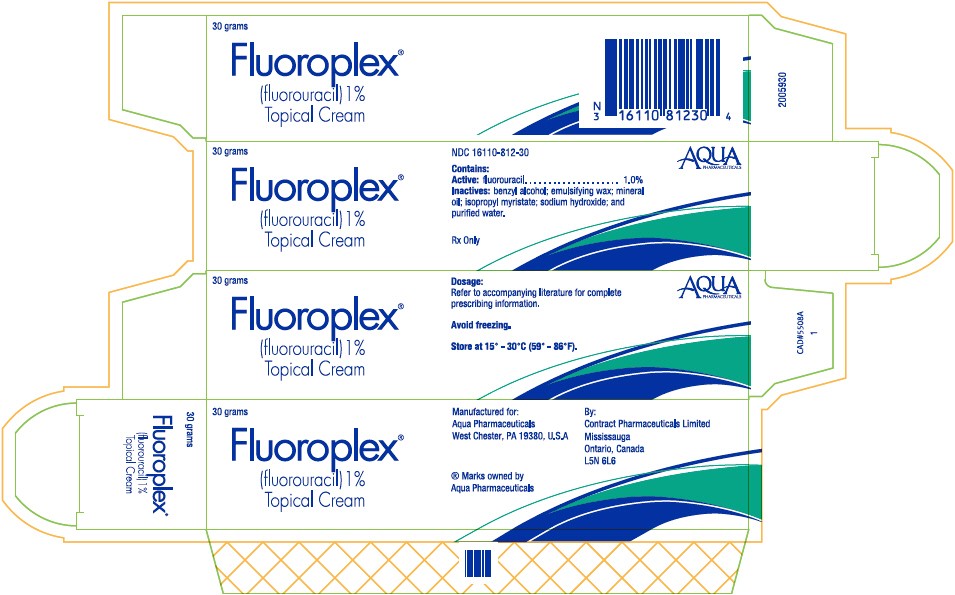Fluoroplex
Fluoroplex (fluorouracil) 1% Topical Cream
FULL PRESCRIBING INFORMATION: CONTENTS*
- FLUOROPLEX DESCRIPTION
- CLINICAL PHARMACOLOGY
- FLUOROPLEX INDICATIONS AND USAGE
- FLUOROPLEX CONTRAINDICATIONS
- WARNINGS
- PRECAUTIONS
- FLUOROPLEX ADVERSE REACTIONS
- OVERDOSAGE
- FLUOROPLEX DOSAGE AND ADMINISTRATION
- HOW SUPPLIED
- REFERENCE
- PRINCIPAL DISPLAY PANEL - 30 g Tube Carton
FULL PRESCRIBING INFORMATION
FLUOROPLEX DESCRIPTION
FLUOROPLEX® (fluorouracil) 1% Topical Cream is an antineoplastic/antimetabolite product for dermatological use. Fluorouracil has the empirical formula C4H3FN2O2 and a molecular weight of 130.08. It is sparingly soluble in water and slightly soluble in alcohol. The pH is approximately 8.5.
Structural Formula:

Chemical Name:
2,4(1H,3H)-Pyrimidinedione, 5-fluoro-.
FLUOROPLEX® 1% Topical Cream contains:
Active Ingredient: fluorouracil 1.0%
Inactive Ingredients: benzyl alcohol, emulsifying wax, isopropyl myristate, mineral oil, purified water, and sodium hydroxide.
CLINICAL PHARMACOLOGY
There is evidence that fluorouracil (or its metabolites) blocks the methylation reaction of deoxyuridylic acid to thymidylic acid. In this fashion, fluorouracil interferes with the synthesis of deoxyribonucleic acid (DNA) and to a lesser extent inhibits the formation of ribonucleic acid (RNA).
FLUOROPLEX INDICATIONS AND USAGE
FLUOROPLEX® Cream is indicated for the topical treatment of multiple actinic (solar) keratoses.
FLUOROPLEX CONTRAINDICATIONS
Fluorouracil is contraindicated in women who are or may become pregnant.
This product should not be used by patients who are allergic to any of its components.
WARNINGS
There exists the potential for a delayed hypersensitivity reaction to fluorouracil. Patch testing to prove hypersensitivity may be inconclusive1.
If an occlusive dressing is used, there may be an increase in the incidence of inflammatory reactions in the adjacent normal skin.
The patient should avoid prolonged exposure to sunlight or other forms of ultraviolet irradiation during treatment with FLUOROPLEX® Cream, as the intensity of the reaction may be increased.
PRECAUTIONS
General
There is a possibility of increased absorption through ulcerated or inflamed skin.
Information for patients
The medication should be applied with care near the eyes, nose, and mouth. Excessive reaction in these areas may occur due to irritation from accumulation of drug. FLUOROPLEX® Cream is applied with the fingers, and the hands should be washed immediately afterward. The reaction to FLUOROPLEX® Cream in treated areas may be unsightly during therapy, and, in some cases, for several weeks following cessation of therapy.
Laboratory Tests
To rule out the presence of a frank neoplasm, a biopsy should be made of those areas failing to respond to treatment or recurring after treatment.
Carcinogenesis, mutagenesis, impairment of fertility
Adequate long-term studies in animals to evaluate carcinogenic potential have not been conducted with fluorouracil. In three in-vitro cell transformation assays, fluorouracil produced morphological transformation of cells. Morphological transformation was also produced in one of these in-vitro assays by a metabolite of fluorouracil and the transformed cells produced malignant tumors when injected into immunosuppressed syngeneic mice. Fluorouracil has been shown to exert mutagenic acitivity in the yeast cells, Bacillus subtilis and Drosophila assays. In addition, fluorouracil has produced chromosome damage at concentrations of 1.0 and 2.0 mcg/mL in an in vitro hamster fibroblast assay and increases in micronuclei formation in the bone marrow of mice at intraperitoneal doses within the human therapeutic dose range of 12-15 mg/kg/day. Patients receiving cumulative doses of 0.24-1.0 g of fluorouracil parenterally have shown an increase in numerical and structural chromosome aberrations in peripheral blood lymphocytes. Fluorouracil has been shown to impair fertility after parenteral administration in rats. In mice, single-dose intravenous and intraperitoneal injections of fluorouracil have been reported to kill differentiated spermatogonia and spermatocytes at a dose of 500 mg/kg and produce abnormalities in spermatids at 50 mg/kg.
Fluorouracil was negative in the dominant lethal mutation assay performed in mice.
Pregnancy
Teratogenic Effects
Pregnancy Category X
Fluorouracil may cause fetal harm when administered to a pregnant woman. Fluorouracil administered parenterally has been shown to be teratogenic in mice, rats and hamsters, and embryolethal in monkeys. Fluorouracil is contraindicated in women who are or may become pregnant. If this drug is used during pregnancy, or if the patient becomes pregnant while taking this drug, the patient should be apprised of the potential hazard to the fetus.
Nursing mothers
It is not known whether this drug is excreted in human milk. Because many drugs are excreted in human milk, and because there is some systemic absorption of fluorouracil after topical administration (see PRECAUTIONS: General ), mothers should not nurse their infants while receiving this drug.
Pediatric use
Safety and effectiveness in pediatric patients have not been established.
FLUOROPLEX ADVERSE REACTIONS
Pain, pruritus, burning, irritation, inflammation, allergic contact dermatitis and telangiectasia have been reported. Occasionally, hyperpigmentation and scarring have also been reported.
OVERDOSAGE
Ordinarily, overdosage will not cause acute problems. If FLUOROPLEX® Cream accidentally comes in contact with the eye(s), flush the eyes(s) with water or normal saline. If FLUOROPLEX® Cream is accidentally ingested, induce emesis and gastric lavage. Administer symptomatic and supportive care as needed.
FLUOROPLEX DOSAGE AND ADMINISTRATION
The patient should be instructed to apply sufficient medication to cover the entire face or other affected areas.
Apply medication twice daily with fingertips and wash hands afterwards. A treatment period of 2-6 weeks is usually required.
Increasing the frequency of application and a longer period of administration with FLUOROPLEX® Cream may be required on areas other than the head and neck.
When FLUOROPLEX® Cream is applied to keratotic skin, a response occurs with the following sequence: erythema, usually followed by scaling, tenderness, erosion, ulceration, necrosis and re-epithelization. When the inflammatory reaction reaches the erosion, ulceration and necrosis stages, the use of the drug should be terminated. Responses may sometimes occur in areas which appear clinically normal. These may be sites of subclinical actinic (solar) keratosis which the medication is affecting.
HOW SUPPLIED
FLUOROPLEX® (fluorouracil) 1% Topical Cream is available in 30 g tubes (NDC 16110-812-30)
NOTE: Avoid freezing. Store at 15° - 30°C (59° - 86°F) in tight containers.
Rx Only
REFERENCE
- Epstein E. Testing for 5-fluorouracil allergy: patch and intradermal tests. Contact Dermatitis 1984; 10:311.
Revised March 2012
Manufactured for:
Aqua Pharmaceuticals
West Chester, PA 19380, U.S.A.
By:
Contract Pharmaceuticals Limited
Mississauga
Ontario, Canada
L5N 6L6
® Marks owned by Aqua Pharmaceuticals
Printed in U.S.A.
4716X
2005931
PRINCIPAL DISPLAY PANEL - 30 g Tube Carton
30 grams
Fluoroplex
®
(fluorouracil) 1%
Topical Cream
NDC 16110-812-30
Contains:
Active: fluorouracil 1.0%
Inactives: benzyl alcohol; emulsifying wax; mineral
oil; isopropyl myristate; sodium hydroxide; and
purified water.
Rx Only
AQUA
PHARMACEUTICALS

Fluoroplexfluorouracil CREAM
| |||||||||||||||||||||||||||||||||||||||||||||||||||||||||||||||||||||